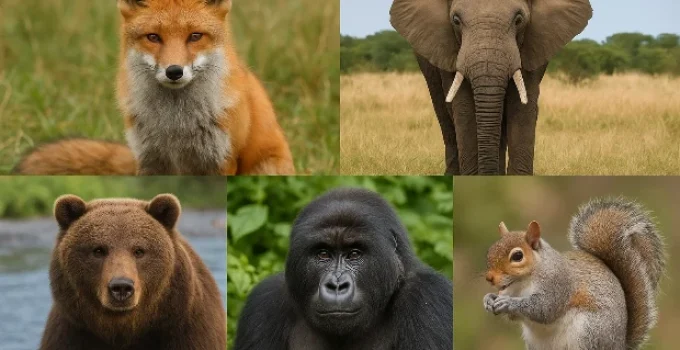Dive Deeper
- Do All Mammals Have Fur?
- Why Do Mammals Have Fur?
- What About Hairless Mammals?
- How Do Aquatic Mammals Stay Warm Without Fur?
- Fur vs. Hair: Is There a Difference?
- Mammals With Unique Hair Traits
- Fur Traits Comparison Table
- 🎯 Final Thoughts
- 📚 References
Do All Mammals Have Fur?
Yes—all mammals have hair or fur at some point in their lives, even if it’s only for a short time. This is one of the most important traits that separates mammals from other animals. Some mammals, like humans, dogs, and bears, are obviously furry. Others, like whales or dolphins, may appear completely hairless—but even they are born with small patches of hair.
So, while not all mammals look fuzzy, they still technically have fur or hair, making this trait a true signature of the mammal class.
🔬 Whiskers are hair? According to the University of Michigan Museum of Zoology, some mammals have whiskers, which are specialized hairs that the animal uses to sense objects.
Why Do Mammals Have Fur?
Fur and hair serve many purposes for mammals, including:
- Insulation: Keeps body heat in, especially in cold weather
- Camouflage: Helps animals blend into their surroundings
- Sensory Function: Whiskers help animals feel things nearby
- Communication: Some animals use fur to show emotions or attract mates
- Protection: Shields the skin from sun and injury
Whether it’s a lion’s mane or a rabbit’s fluffy coat, fur has evolved to meet many different needs.
🐇 Mammals change color? According to the American Museum of Natural History, some mammals change fur color with the seasons to stay hidden from predators.
What About Hairless Mammals?
Some mammals appear hairless, but they still have hair follicles or develop small amounts of hair early in life. These include:
- Whales and dolphins: Have hair when born, often on the snout
- Naked mole rats: Nearly hairless but still have a few sensitive hairs
- Humans: Compared to other primates, we have very fine body hair
- Elephants: Have sparse, thick hair that gets thinner with age
So, even the “baldest” mammals still count as furry by scientific standards.
🐋 Even dolphins have hair? The National Oceanic and Atmospheric Administration (NOAA) confirms that dolphins have a tiny amount of hair around their blowholes.
How Do Aquatic Mammals Stay Warm Without Fur?
Aquatic mammals like whales, seals, and manatees face a challenge: cold water takes heat away fast. Instead of relying on thick fur, they use:
- Blubber: A thick layer of fat under the skin for insulation
- Streamlined skin: Helps them swim fast and efficiently
- Hair at birth: Some species have a newborn “lanugo” coat that is later shed
Fur-covered aquatic mammals like sea otters are the exception. They have the densest fur of any animal, with up to 1 million hairs per square inch!
🦦 Did You Know? The fur or hair covering an animal is called “pelage.”
Fur vs. Hair: Is There a Difference?
Not really! Scientists consider fur and hair to be the same thing. The difference is usually in how we use the words:
- Fur: Thicker, shorter, and covers the body (like on a dog or cat)
- Hair: Longer, finer, or found in fewer places (like on humans or horses)
But both are made of the same protein—keratin—and grow from the same type of follicle.
💡 According to Scientific American, fur and hair are biologically the same; the terms just reflect texture and function.
Mammals With Unique Hair Traits
Some mammals use their fur or hair in unusual ways:
- Porcupines: Modified hairs called quills for defense
- Armadillos: Sparse hairs between bony plates
- Sloths: Fur grows in reverse direction to drain rainwater
- Pangolins: Covered in scales, but still have hair underneath
These show how adaptable mammal hair can be in different environments!
🦔 According to the US National Park Service, porcupines are covered in ~ 30,000 quills! They can’t shoot them from their bodies but they do grow new ones in place of the ones they lose.
Fur Traits Comparison Table
| Mammal | Fur/Hair Type | Purpose or Adaptation |
|---|---|---|
| Polar Bear | Thick fur | Warmth in Arctic cold |
| Human | Fine hair | Reduced body coverage |
| Sea Otter | Extremely dense fur | Insulation without blubber |
| Dolphin | Hair at birth only | Sensory role early in life |
| Naked Mole Rat | Sparse sensory hairs | Tunnel navigation |
| Porcupine | Sharp quills (hair) | Protection from predators |
🎯 Final Thoughts
So, do all mammals have fur? Yes—every single one has hair or fur at some point, even if it’s just a little. Whether it’s the thick coat of a bear or the tiny hairs on a dolphin’s face, fur is one of the defining features that makes an animal a mammal. This unique trait helps mammals survive in deserts, oceans, forests, and even underground tunnels.
📚 References
💻University of Michigan Museum of Zoology. “Mammalia.” https://animaldiversity.org/accounts/Mammalia/
💻American Museum of Natural History. Camouflage. https://www.amnh.org/explore/ology/ology-cards/187-camouflage
💻The National Oceanic and Atmospheric Administration (NOAA) “Are Dolphins Fish?” https://oceanservice.noaa.gov/facts/dolphin.html
💻US National Park Service. “Sea Otter.” https://www.nps.gov/places/sea-otter.htm
💻Scientific American. “What Is the Difference Between Hair and Fur?” https://www.scientificamerican.com/article/what-is-the-difference-be/
💻US National Park Service. “Fast Fact: Porcupines.” https://www.nps.gov/articles/000/fast-facts-porcupines.htm
📌Learn More About Mammals
- When Do Squirrels Hibernate? 🐿️How These Smart Survivors Outsmart Winter
- What Makes an Animal a Mammal? 🐾 The Traits That Set Mammals Apart
- What Does Warm-Blooded Mean? 🌡️ Animals That Bring the Heat (Literally)
- Which Mammals Lay Eggs? 🥚 The Eggstraordinary Rule-Breakers of the Mammal World
- Do Marine Mammals Breathe Underwater? 🐬 Explore How They Survive in the Sea
